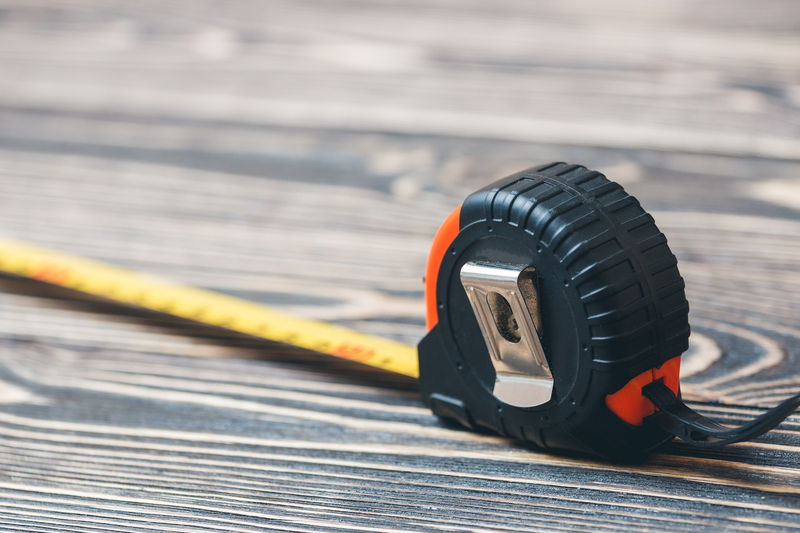Expert Tricks for Sofa Preservation during Long-Term Storage
Posted on 22/05/2025
Expert Tricks for Sofa Preservation during Long-Term Storage
Preserving your sofa during long-term storage is crucial to maintain its value, comfort, and appearance. Whether you're moving, downsizing, or redecorating, taking the right steps ensures your couch stays in pristine condition until it's ready to reclaim its place in your home. This guide provides comprehensive, SEO-optimized expert tips for keeping your sofa safe during extended storage periods, helping you protect your investment--and your comfort--for years to come.
Why Proper Sofa Preservation Matters
Your sofa isn't just a place to rest--it's a centerpiece of your living space and a significant financial investment. Improper long-term storage can lead to:
- Mold and mildew growth
- Pest infestations
- Structural warping and sagging
- Fabric discoloration and deterioration
- Unpleasant odors
To avoid these issues, follow these expert sofa storage tricks and keep your furniture looking and feeling as good as new.

Prepping Your Sofa for Long-Term Storage
1. Thoroughly Clean the Sofa
Dirt, crumbs, dust, and oils can damage your couch over time--especially if left undisturbed for months on end. Before storing, give your sofa a deep and gentle clean:
- Vacuum all cushions and crevices to remove debris and dust mites.
- Spot clean any stains with appropriate fabric or upholstery cleaners.
- Condition leather surfaces (if applicable) with a specialized leather conditioner.
- Allow the sofa to air dry thoroughly before wrapping or covering, as trapped moisture fosters mold and mildew.
2. Disassemble for Easy Storage
If possible, disassemble your sofa into manageable pieces. Remove legs, cushions, arms, or other detachable components. This makes it easier to move, reduces the risk of damage, and helps optimize storage space for long-term protection.
Tip: Store hardware and bolts in labeled zip bags taped to a main sofa part to avoid losing them!3. Protect the Sofa with the Right Materials
Never rely solely on plastic wrap for long-term furniture storage! While it keeps out dust and pests, it can trap moisture and promote mildew. Instead:
- Wrap cushions and exposed fabric in clean cotton sheets or moving blankets
- Use breathable sofa covers or dust covers made of canvas or fabric
- If you must use plastic, ensure it's loose and has ventilation holes to allow airflow
Best Places to Store Your Sofa Long-Term
4. Choose the Right Storage Unit
Climate-controlled storage units are the gold standard for extended sofa storage. Extreme temperatures or humidity levels can warp wood, crack leather, and ruin fabrics. Look for:
- Stable temperatures (around 55-80?F/13-27?C)
- Humidity control (ideally 30-50%)
- Good ventilation to reduce the risk of mold
- Solid, waterproof floors to prevent water damage
5. Raise the Sofa Off the Ground
Never store your sofa directly on the floor--even in a high-quality storage unit. Use wooden pallets, blocks, or risers to elevate the couch and prevent contact with moisture, dirt, or fluctuating temperatures at ground level. This simple trick safeguards your sofa's legs, frame, and upholstery against unexpected leaks or pests.
Arranging Sofas in Long-Term Storage
6. Avoid Stacking and Heavy Pressure
It's tempting to stack items densely in a storage unit to save space, but never place heavy objects on top of your sofa. Prolonged pressure can:
- Deform the sofa's cushions and padding
- Bend or warp the frame
- Damage delicate upholstery
Leave enough room around the sofa for airflow. Don't crowd it against walls or other furniture, as this promotes hidden mold growth and restricts ventilation.
7. Monitor for Pests and Moisture
Even in well-maintained storage facilities, pests (such as rodents and insects) and moisture can infiltrate. Reduce risk by:
- Utilizing natural pest deterrents like cedar blocks or lavender sachets tucked around the base
- Placing moisture absorbers (e.g., silica gel packets or baking soda boxes) near the sofa
- Regularly inspecting your sofa if possible--every few months, stop by to check for signs of damage, dampness, or droppings
Special Considerations Based on Sofa Materials
8. Preserving Leather Sofas during Long-Term Storage
Leather is particularly sensitive to humidity and heat. To keep your leather couch supple and clean:
- Apply a leather conditioner before storage to prevent cracking
- Cover with a breathable cloth, avoiding plastic wrap entirely
- Check periodically for mildew or sticky residues
9. Storing Fabric and Microfiber Sofas
These materials attract dust and absorb odors. For best results:
- Clean and vacuum thoroughly
- Use fabric-safe protection sprays to repel future stains
- Opt for covers that shield against dust without suffocating the fabric
10. Safeguarding Wooden and Metal Sofa Elements
Wooden legs and frames can warp; metal parts can rust. Combat this by:
- Applying wood polish or protectant
- Cleaning and drying all metals, then using an anti-rust spray if needed
- Wrapping legs and arms with padding to prevent scratches or nicks
Expert Tricks & Pro Tips for Ultimate Sofa Storage Longevity
11. Use Scented Sachets and Baking Soda
Keep odors away by placing scented sachets or open boxes of baking soda under the sofa covers. These absorb moisture and provide a pleasant scent when you finally unveil your sofa again!
12. Take Photographs and Keep a Sofa Inventory
For high-value or sentimental sofas, photograph your sofa before, during, and after prepping. This documentation:
- Provides proof of condition for insurance or storage disputes
- Helps you recall how to reassemble disassembled parts
- Acts as a memory aid for your organization plan
13. Label All Parts Clearly
For modular or sectional sofas, label each part and keep assembly instructions handy. This prevents confusion (and frustration!) when it's time to move your couch back home.
14. Don't Forget Insurance
Even the best storage plans can go awry. Confirm whether your sofa is covered under renters or homeowners insurance, or if your storage facility offers supplemental coverage. It's a small investment for priceless peace of mind.
Cleaning and Reinstalling Your Sofa after Long-Term Storage
15. Unwrap and Air Out
After months in storage, your sofa will benefit from a good airing before returning to regular use:
- Remove all coverings and wrappers in a well-ventilated area
- Let the sofa "breathe" for at least 24 hours to dispel any odors
16. Inspect Thoroughly for Issues
Before moving your sofa into its final spot:
- Check for mold, mildew, or pest damage
- Look for any water stains or warping
- Ensure metal or wooden parts are dry and intact
17. Restore and Refresh as Needed
Depending on your sofa's condition, you may want to:
- Vacuum, steam clean, or gently wipe the upholstery
- Reapply leather conditioner (for leather sofas)
- Replace or fluff cushions
- Tighten or reassemble hardware

Frequently Asked Questions about Sofa Preservation in Storage
How long can a sofa stay in good condition in storage?
With correct sofa storage techniques, your couch can remain in excellent condition for one to five years or longer. The key factors are climate control, proper preparation, and periodic checks.
Can I store a sofa without climate control?
While possible, non-climate-controlled storage increases the risk of damage. If you must store your sofa this way, prioritize breathability, moisture barriers, and elevate your couch to reduce exposure to temperature extremes and humidity.
What should I do if my sofa develops mold or pests during storage?
If you notice signs of mold or pests upon retrieval:
- Remove contaminated covers immediately
- Clean affected areas with appropriate solutions (fabric-safe disinfectant, mild bleach for hard surfaces)
- Thoroughly dry and air out in sunlight if possible
- Consider professional cleaning for persistent issues
Conclusion: Enjoy Your Perfect Sofa for Years to Come
Investing time and effort in expert sofa preservation strategies for long-term storage will undoubtedly pay off. These techniques not only help your sofa survive a lengthy hiatus but ensure it returns to your living room in the same (or even better) condition. By following these expert tricks for preserving your sofa during long-term storage, you're guaranteeing that your favorite couch remains as inviting, stylish, and comfortable as ever--no matter how long it waits for you in storage.
Trust these time-tested, professional-approved methods to extend your sofa's life, so you and your family can enjoy its comfort and elegance far into the future.



